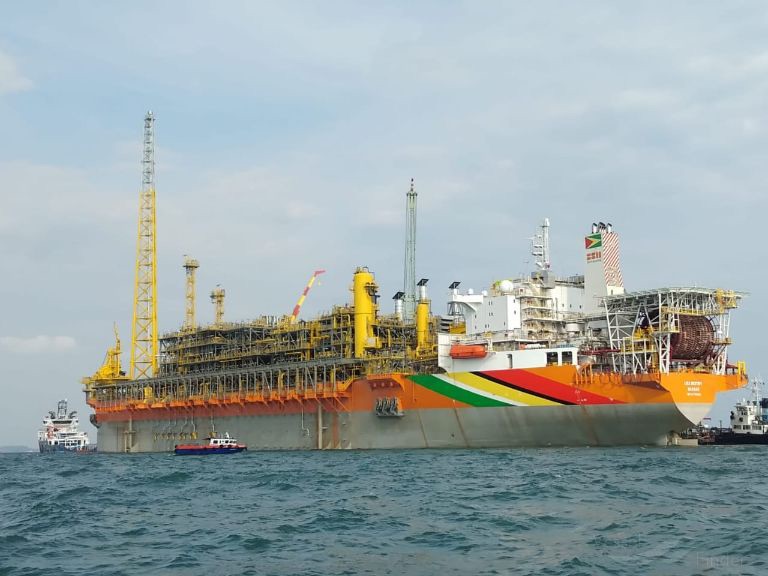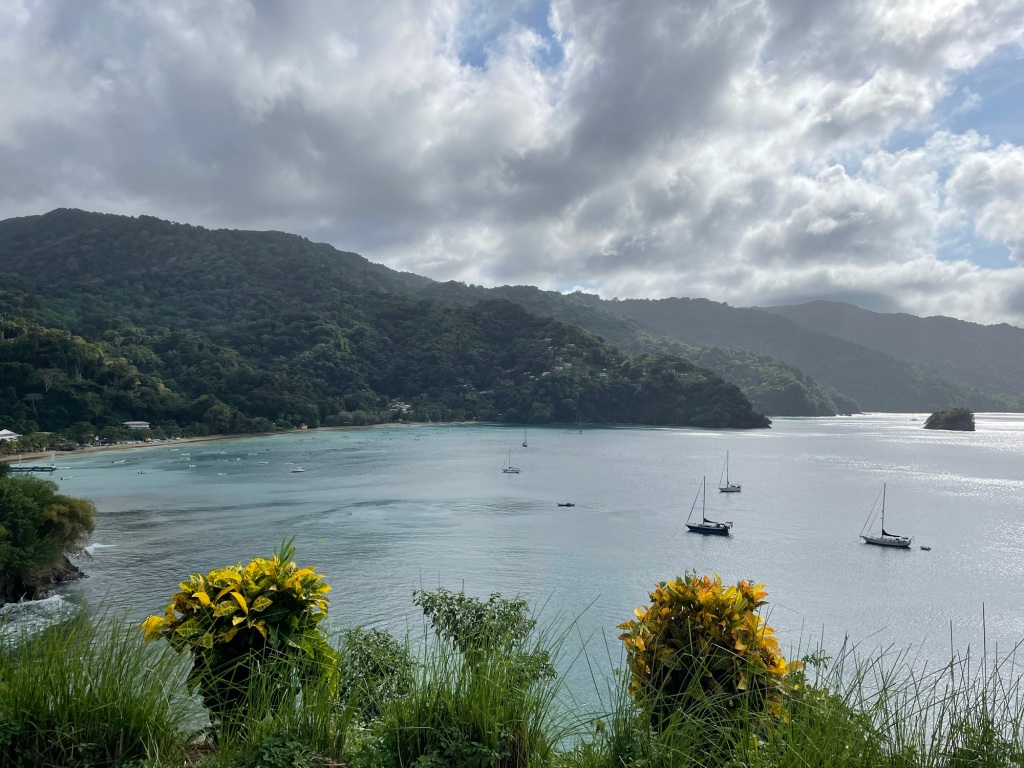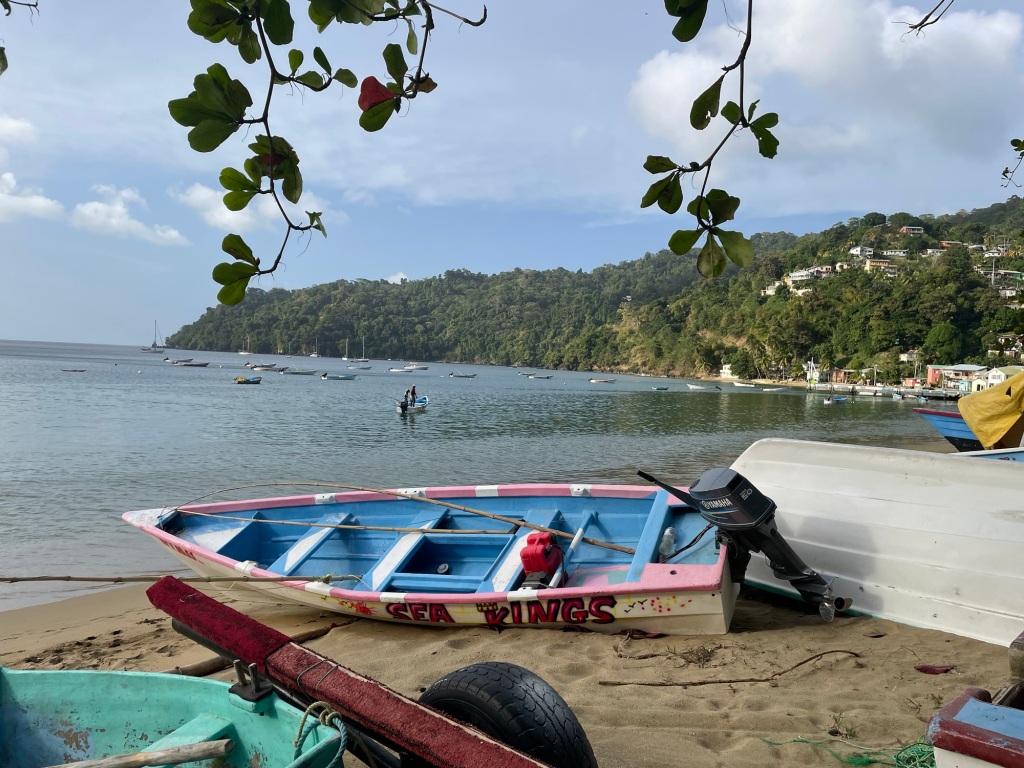1st to 10th February 2024

Though I enjoyed the weeks spent in Suriname, I was happy to leave the swirling and filthy river anchorage with its hungry mosquitoes and howling monkeys and head for the open sea once more. Next stop Tobago.
There’s a very helpful ocean current to speed the trip from Suriname to Tobago. It’s a voyage of about 480 miles and could readily be sailed in under three days; but being nervous about the state of Henrietta’s rigging (because, though new toggles were fitted, I’d found broken wire strands in upper rigging), I’d allowed nearly four days. In an effort to slow down and arrive both in daylight and avoiding immigration’s high overtime charges, Henrietta ended up with just a scrap of genoa for most of the voyage.
On the way and in the middle of the second night I ran into an offshore oil/gas production area, the Liza Field. It’s about 150 miles off the coast of Guyana and was not marked on my chart. Lights and boats are everywhere. It is extraordinary to come across these vast brightly lit, floating oil rigs that somehow stay almost stationery while extracting the goods.
The particular rig/vessel I get close to, before a warning tug calls me on the radio and asks me to alter course ( “you must stay away 2 miles”, I was told but was already less than one). This one, Liza Destiny, seems to be nearly 350 metres long. It’s lit more brightly than the Blackpool illuminations, with flame billowing at the top of a mighty tower, and a fleet of auxiliary vessels scurrying about doing their stuff.

There’s a surreal sense of doom with all this ugly human activity beneath a fine dark starlit night sky. But, oh how we need our oil; how we love our motor cars, our cheap air travel and all the comforts that we suppose we need.
I was so intrigued with this unmarked oil field that I’ve since looked up the Liza Field on the internet. It’s quite new. Liza Destiny, I read, is anchored in a water depth of 1,525 metres! That’s an awful lot of chain. (Us little yachts, think anchoring in anything over 20 metres is getting a bit deep) Liza Destiny was originally built in 1999 as a Very Large Crude Carrier named Tina, but was converted in a Singapore shipyard in 2018. Nowadays it can extract 140,000 barrels of oil a day.
And on the subject, I’d like to add that mankind does seem to get away with all manner of dreadful activities when a long way out of sight of land, especially in the middle of our oceans. Oil rigs, squid fishing, krill hunting, offshore wind (not as ‘clean’ as you’re led to believe) and ocean dumping, to name a few I’ve come across.
On a brighter note, sweeping into Man of War Bay, in the north of Tobago, just after dawn I nearly collide with a giant leatherback turtle. We pass scarcely two metres apart, but he or she seems unconcerned and just raises a placid head as if to say ‘hello’ and greet me (or maybe it’s just to say “oh go away, can’t you see I’m trying to sleep!”. There are frigate birds and a few pelicans soaring overhead and, together with the dense green forest that cloaks the cliffs, this little arrival town of Charlotteville seems enchanting.


It takes many hours to go through arrival clearance formalities. There’s a power cut and the immigration computer doesn’t work. Nor does the ATM, so no money to pay for the visa; and no local wifi either so no way of downloading the essentials of life on land. Sailors learn restraint and patience as key virtues of liveaboard life!

It doesn’t take long to appreciate that I like Tobago a lot, at least the little bit I’ve seen.

Everyone seems exceedingly laid back. Even immigration and customs staff, who are two ladies rather in the style of Mma Ramotswe of McCall Smith’s No.1 Ladies Detective Agency novels, are strict with the rules but pretty good-natured in applying them. Fishermen (who practice line fishing with long bamboo poles swept to each side of their small high powered craft) wave and smile. Their boats have wonderful names painted in large colourful letters: “Rebellious”, “Black Face”, and my favourite, “Joyous Vibes”.

There’s a contingent of Dutch sailors, also arrived from Suriname. As ever it’s good to find familiar faces and share local information. Wifi available for a nominal fee in the local library (air conditioning too); delicious veggie ‘roti’ from the stall where a thin and elderly Rastafarian serves with a friendly smile. (I think he and I might be the oldest men in the place!); a few ok spots for snorkelling.

After a few days walking, swimming, talking and dozing, it’s time to leave and find somewhere with the skills to make new rigging and try to sort electric troubles (again!). I spend my last night along the Tobago coast, past Bloody Bay, in Englishman’s Bay. (Place names here are evocative of many colonial tussles.)
It’s too rough to land but Englishman’s Bay is a gem of Tobago beauty, a perfect tropical bay. Waves crash onto a clean golden beach that’s backed with a haphazard line of coconut palms. Behind that the dark green forest clings to cliffs and hillsides, with a few local homes or tourist places nestled among the trees.

Next stop Martinique. In harsh contrast to Tobago it’s packed with thousands upon thousands of yachts, charter catamarans and whizzy water toys of all sorts.
Even in the few years I’ve been visiting this island I guess boat numbers have doubled. It seems true of most of the East Caribbean islands too: over crowded, overpriced and overrated.
On the plus side, it is hot and sunny with good sailing winds and, at least in Martinique, there are technical skills to get your boat going again. And the French overseas have mastered the art of immigration formalities too: one sheet of paper, three minutes and €3, and you’re in! Lessons here perhaps for all immigration authorities who deal with sailing boats?

Thanks Mike, so beautifully written as always. Wish we were in Tobago and not gloomy UK… hope you get the rigging fixed. Best wishes Anne and Richard Saunders
LikeLike
Interesting. Were there two yachts on the rocks in Charlottesville!?
LikeLike
Not that I saw.
LikeLike